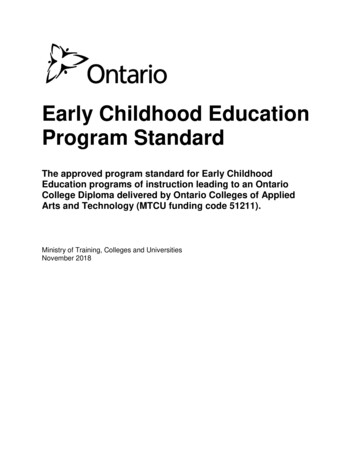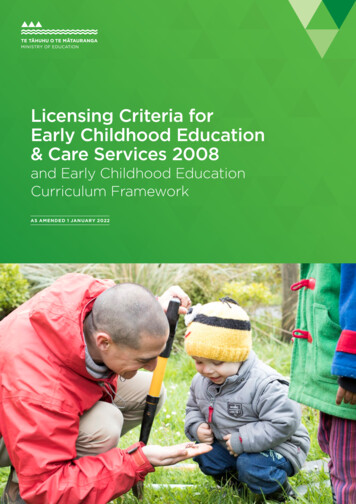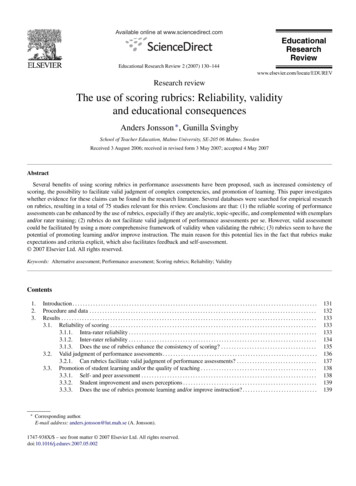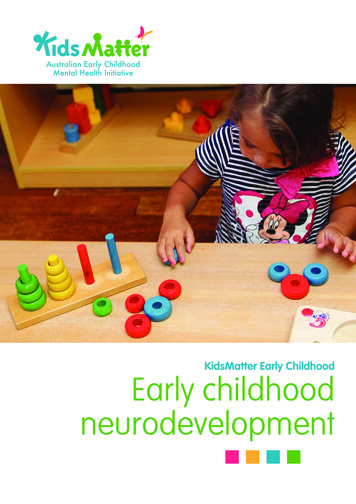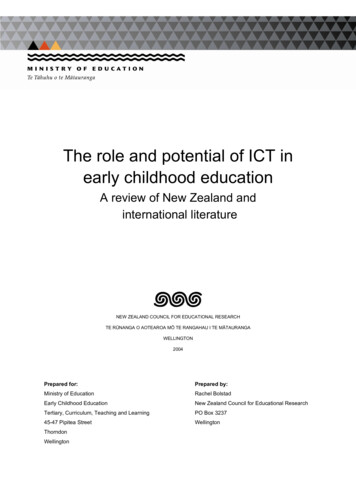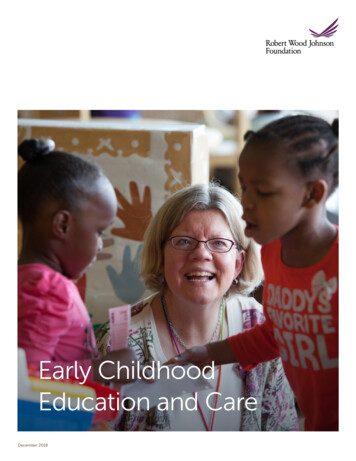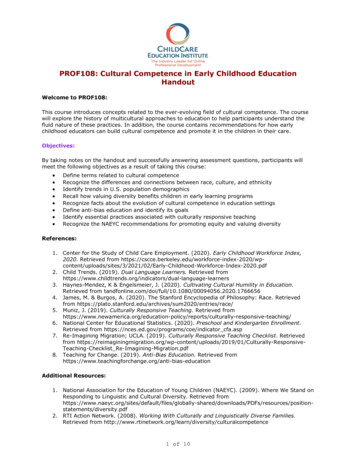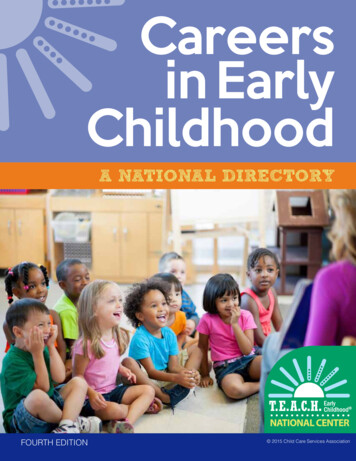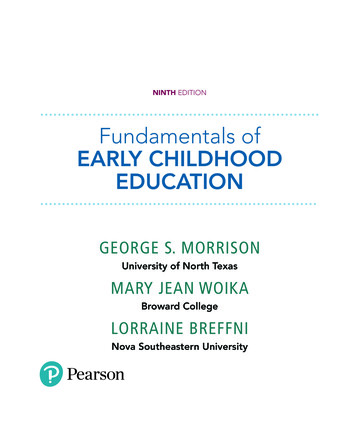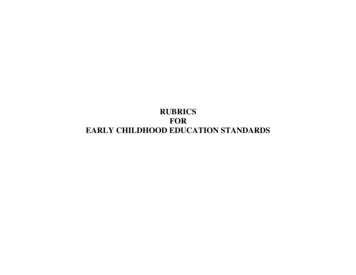
Transcription
RUBRICSFOREARLY CHILDHOOD EDUCATION STANDARDS
SOE STANDARD – 1 Disciplinary FoundationsRUBRIC FOR ASSESSMENT OF ASSIGNMENTS AND PORTFOLIO ARTIFACTSDisciplinary foundations: demonstrates interpretive, normative, critical understanding of educational phenomenon through the use of the humanities, socialsciences and psychological sciences within the disciplinary foundations of education (e.g., anthropology, history, philosophy and psychology of education)DOES NOT MEETMEETSEXCEEDS(undergraduate/graduate level )(undergraduate/graduate level)(undergraduate/graduate level)Understands in a limited orDemonstrates a beginningDemonstrates exceptional and sophisticatedKnowledge Bases ofperfunctory way one or more of(minimum), and general awarenessappreciation, clarity, creativity andDisciplinary Foundationsthe disciplinary foundations asand appreciation of one or more ofcritical/analytical understanding of one orrelated to the interpretive study of the disciplinary foundations asmore of the disciplinary foundations asthe social and cultural contextsrelated to the interpretive study of the related to the interpretive study of the socialand complexities of educationalsocial and cultural contexts andand cultural contexts and complexities ofphenomenon and/or praxis. (e.g.,complexities of educationaleducational phenomenon and/or praxis. (e.g.,no appreciation for thephenomenon and/or praxis (e.g., canexhibits analytical sophistication.)interpretive study of educationalidentify and summarize the essentialphenomenon as related to theor core ideas, concepts and theories.)disciplinary foundations ofeducation)Exhibits little or no interests inExhibits a general appreciation forDemonstrates an exceptional andModes of inquirydeveloping the critical/analyticaldeveloping the critical/analyticalsophisticated ability to critically/analyticallyskills and understanding for using skills and understanding necessaryuse interpretive modes of educational inquirythe interpretive modes offor using interpretive modes ofto develop systematic logical argument(s)educational inquiry as related toeducational inquiry related to theand synthesis issues and ideas related to oneone or more of the disciplinarydisciplinary foundations knowledgeor more of the disciplinary foundations offoundations knowledge bases.bases.education knowledge bases.Exhibits little or no appreciationExhibits a general appreciation forDemonstrates an exceptional andInterpreting Educationalfor past and present ideas,the past and present ideas in thesophisticated appreciation of past and/orFrameworkstheories and/or intellectualinterpretive study of educationalpresent ideas, theories and/or intellectualtraditions in one or more of thephenomenon and/or praxis as related traditions for the interpretive study ofdisciplinary foundations ofto one or more of the disciplinaryeducational phenomenon and/or praxis (e.g.,education as it relates to thefoundations knowledge bases. (e.g.,exhibits an extraordinary desire to creatively,interpretive study of educationaldesires to make connections between critically and systematically interpret thephenomenon and/or praxis.past and/or present theories and/orconnections between past and/or presentintellectual traditions)theories and/or intellectual traditions.Prepared by Stephen Haymes June 5, 2002
SOE STANDARD -- 2 TransformationRUBRIC FOR ASSESSMENT OF ASSIGNMENTS AND PORTFOLIO ARTIFACTSTransformation: Demonstrates an understanding of the human transformative dimension of educational phenomenon and/or praxis at the level of the self and/orthe social.DOES NOT MEETMEETSEXCEEDS)(undergraduate/graduate level )(undergraduate/graduate)(undergraduate/graduate level)Understands in a limited orDemonstrates a beginningDemonstrates exceptional and sophisticatedUnderstanding Frameworks ofperfunctory way theoretical(minimum), and general awarenessappreciation, clarity, creativity andTransformationframeworks of humanand appreciation for theoreticalcritical/analytical understanding fortransformation in social andframeworks of human transformation theoretical frameworks of humancultural contexts as related toin social and cultural context astransformation in social and cultural contexteducational phenomenon and/orrelated to educational phenomenonas related to educational phenomenon and/orpraxis (e.g., no appreciation forand/or praxis (e.g., exhibits anpraxis. (e.g., exhibits analyticalthe educational study of humanappreciation and desire to know; cansophistication and exceptional appreciationtransformation in social andidentify and summarize the essentialfor the educational study of humancultural contexts.or core ideas, concepts and theoriestransformation in social and culturalas related to the educational study ofcontexts)human transformation in social andcultural contexts.Exhibits little or no interests inExhibits a general appreciation forDemonstrates an exceptional andAnalytical Skills ofdeveloping the ability anddeveloping the ability andsophisticated ability and use ofTransformationcritical/analytical skills necessary critical/analytical skills necessary tocritical/analytical skills necessary toto understand and appreciate theunderstand the organizing principlesunderstand the organizing principlesorganizing principles influencinginfluencing the educational dynamics influencing the educational dynamics ofthe educational dynamics ofof human transformation.human transformation.human transformation.Prepared by Stephen Haymes, June 5, 2002
SOE STANDARD -- 3 Identity DevelopmentRUBRIC FOR ASSESSMENT OF ASSIGNMENTS AND PORTFOLIO ARTIFACTSIdentity Development. Understands the sociocultural process of human development over the lifespan and historical time, the dynamic of identity constructionthrough interpersonal and societal relations, and the role of individual agency and collective action in bringing about personal and social transformation.DOES NOT MEETMEETSEXCEEDS)(at the preservice level )(at the preservice level)(at the preservice level)Demonstrates a limited (rote) understanding Demonstrates a basic understanding Demonstrates a profound understanding of theDisciplinary Bases ofof the social and cultural dimensions ofof human development as a social,social, psychological, and cultural dimensionsIdentity Developmenthuman development. Exhibits limitedpsychological, and cultural processof human development within the lifespan andability or an unwillingness to engage newwithin and across generations (e.g.across historical time. Poses thoughtful,ideas, theories, and concepts, or to considerarticulates and compares focalinsightful questions and initiates analytical,the ways in which social, cultural andtheoretical perspectives, theirtheoretically grounded,institutional factors shape humanimplications, and limitations).interdisciplinary inquiry to examine anddevelopment.address complex issues regarding human life.Human Developmentand IdentityTransformationProcessesDemonstrates a limited interest in orunderstanding of the role of power andprivilege in the construction of identitiesand the processes of human growth andchange. Demonstrates an inability toconsider, embrace, or systematicallychallenge new ideas through writteninquiry, analysis, or discussion, or debate.Demonstrates a basic, minimalunderstanding of the role of socialinstitutions and power relationshipsin constructing/ contesting identitiesand processes of humandevelopment. Has a beginningappreciation for the sociologicaldimensions as well as thepsychological dimensions of humandevelopment.Demonstrates a broad-based understanding ofthe complex role of institutions and societalrelations of power and privilege in theconstruction of identities and in shapingmultiple aspects of human growth and change.Demonstrates a sophistication in interrogatingand synthesizing the multifaceted, complexinterdependent relationship betweenindividuals and social dimensions of humanthought and activity.Understanding IdentityDimensionsDemonstrates limited understanding ofidentity as a social construction and theinterdependence of dimensions of identity.Displays an inability or unwillingness to beself-reflexive or develop the skills/tools tounderstand the significance ofdimensions of identity.Demonstrates a generalunderstanding and appreciation ofdimensions of identity, e.g. race,social class, and gender asinterdependent social constructionsthat are forged in the context ofsociohistorical relationships.Self-ReflectiveProcessesDemonstrates little understanding of or isunable to grasp the sociocultural orhistorical nature of the process of identityformation, e.g. is unable to simultaneouslyDemonstrates a self-reflectiveunderstanding of identity as asociocultural, historical process ofmeaning-making on the individualDemonstrates profound understanding of thesociocultural/historical construction ofidentities created in the context ofsocioeconomic and political relationships.Able to critically examine, self-reflexivelyengage, and problematize identificatorymeanings, lived experiences and institutionalpractices that inform concepts andrepresentations of the self and other.Demonstrates a deep, self-reflectiveunderstanding of the sociocultural andhistorical process of identity formation.Exhibits an ability to analyze and examine the
consider individual-psychological and thesocial-relational nature of human growthand change.and social level.complex relationship between maturationalprocesses at the individual level andsociohistorical processes at the societal level.Institutional andHuman Roles inIdentity ConstructionDemonstrates a limited understanding of therole of institutions or societal structures inthe construction of individual and socialidentities.Demonstrates a basic understandingof the role of institutions and humanagency in. shaping and contestingidentity constructions in the contextof social relations.Difference andMultivocalityDemonstrates a limited or no understandingof difference or multivocality in educationand the importance of social equity inpromoting human growth and change.Demonstrates an understanding ofdifference and multivocality ineducation in promoting social equityand human growth and change, e.g.curriculum, policy, professionalpractice.Demonstrates an understanding of the role ofhuman agency and institutions in processes ofidentity construction that promote personal andsocial transformation. Illustrates an interest inand commitment to critically examine andinterpret theoretical perspectives, institutionalpolicy and social practice as they inform theconstruction andnegotiation of identities.Demonstrates a profound understanding ofdifference and multivocality in multipleeducational sites in promoting/inhibitinghuman growth and change. Values anddemonstrates the ability to interpret andsynthesize a multiplicity of voices andtheoretical perspectives and to consider theirimplications for educational policy and practice
SOE STANDARD – 4 Understanding DifferenceRUBRIC FOR ASSESSMENT OF ASSIGNMENTS AND PORTFOLIO ARTIFACTSUnderstanding Difference. Understands the multiple subjectivities and social relations of race, ethnicity, class, gender, and sexuality as they define a range ofpossibilities for all youth irrespective of differences.DOES NOT MEETMEETSEXCEEDS)(at the preservice level )(at the preservice level)(at the preservice level)Demonstrates a limitedUnderstands that race, social class,Demonstrates a broad understanding of andSocial Relations of Inequalityunderstanding of the socialgender and other dimensions ofability to examine the multiple expressions ofconstructs of race, social class,identity are social constructs thatsocietal relations of power and privilege thatand gender, and are unable togrow out of relations of power thathistorically frame the constructs of race, socialgrasp the hierarchicalprivilege some and marginalizeclass, gender, etc. and frame the livedrelationships in societyothers.experiences of individuals and dynamicsthat institutionalizes privilegedamongst groups within/across institutions andpositions for some andnational boundaries.marginalized positions for others.Understands that identityDemonstrates an understanding of the complexMultiple Dimensions of Identity Demonstrates a limitedunderstanding of the relationshipconstruction processes mutuallythe relationship between the construction ofbetween an individual’s orinform individuals’ lived experiencesocial identities, individuals’ lived experiencesgroup’s lived experience andand social position across socialand perceptions, and the relative positions ofsocial position as it contributes to contexts and that individualspower and privilege of marginalized/dominantthe interdependent individual and negotiate multiple dimensions ofgroups that reaffirm/ contest the identificatorysocial identities constructed.identity that are informedconstructs. Understands the contradictory andby and frame their lived experiencecomplex negotiations of meaning that areand social position across socialinterdependently created through ancontexts.individuals' and groups’ lived experience andsocial position.Demonstrates a limitedUnderstands that educationalDemonstrates an understanding of the complexEducational contexts andunderstanding of and interest incontexts are instrumental in theand multifaceted role of social institutions,identity constructionthe role of educational institutions construction of identities, that thesepedagogical practices and structures of power,and pedagogical practices in theconstructs inform individual/in constructing identities and promotingconstruction of dimensions ofcollective expressions of/reactionsideological formations that mutuallyidentity and a limitedto individual/collective difference,reinforce/contest hierarchical socialunderstanding of the role of social and can reinforce social hierarchiesrelations in educational and other institutions,constructs in maintenance/of power.both nationally and globally.disruption of relations of socialinequity.
EARLY CHILDHOOD STANDARD -- TEACHING & LEARNING - CONTENT KNOWLEDGE -ENGLISH/LANGUAGE ARTSRUBRIC FOR ASSESSMENT OF ASSIGNMENTS AND PORTFOLIO ARTIFACTSTeaching and Learning B Understanding Content Knowledge in Early Education. Understands the importance of English/Language Arts in youngchildren s learning. Knows the essential concepts, inquiry tools, and structure of content areas including academic subjects and can identify resources to deepentheir understanding.DOES NOT MEETMEETSEXCEEDS(at the preservice level )(at the preservice level)(at the preservice level)Conceptual understanding of allDemonstrates ample conceptualConsistently evidences superior conceptualLinguistic principlescomponents of English content, structureunderstanding of all components ofunderstanding of all components of Englishand conceptsand use is nominal or inadequateEnglish content, structure and usecontent, structure and useShows adequate understanding of childShows extensive knowledge and mastery ofLanguage acquisition Shows limited understanding of childdevelopment theories as they pertain todevelopment theories as they pertain tochild development theories as they pertainand developmentfirst and/or second language acquisitionfirst and/or second language acquisitionto first and/or second language acquisitiontheoriesand developmentand developmentand developmentUnderstanding of the reciprocal nature ofUnderstands the reciprocal nature of oralConsistently evidences superior conceptualReciprocaloral and written language processes andand written language processes and howunderstanding of the reciprocal nature ofRelationshipshow they foster each other throughthey foster each other through instructionoral and written language processes andinstruction and use is insufficient orand usehow they foster each other throughincorrectinstruction and useUnderstanding of basic language artsDemonstrates adequate understanding ofDemonstrates extraordinary understandingLanguage artscurriculum content and skills sequence and basic curriculum content and skillsand mastery of basic curriculum content andcurriculum andor knowledge of Illinois Language Artssequence and of Illinois Language Artsskills sequence and extensive knowledge ofsequenceLearning Goals is insufficientLearning GoalsIllinois Language Arts Learning GoalsProvision of opportunities for developingProvides many opportunities forProvision of opportunities for developingProviding Learninglistening, speaking and writing and/ordeveloping listening, speaking and writing listening, speaking and writing and/orOpportunitiesexploring many types of listening,and explores many types of listening,exploring many types of listening, speakingspeaking and writing situations isspeaking and writing situationsand writing situations is extensive,insufficient or ineffectiveinsightful, and highly effectiveUnderstanding of material types and usesSeeks, plans, and/or uses a variety ofDemonstrates thorough knowledge of andMaterials forin language arts instruction is inadequateappropriate materials in language artsability to use a variety of materials forinstructionor inappropriateinstructionlanguage arts instruction
EARLY CHILDHOOD STANDARD – LANGUAGE ARTS: LITERACY TECHNIQUES & STRATEGIESRUBRIC FOR ASSESSMENT OF ASSIGNMENTS AND PORTFOLIO ARTIFACTSLanguage Arts: Literacy Techniques & Strategies. Knows a broad range of literacy techniques and strategies for every aspect of communication and must beable to develop each student's ability to read, write, speak and listen to his or her potential within the demands of the discipline.DOES NOT MEETMEETSEXCEEDS(at the preservice level )(at the preservice level)(at the preservice level)Appreciation for the needs for literacyUnderstands the need for literacyAppreciation for the need for literacyCommitment todevelopment in general and/or thedevelopment in general and is committeddevelopment in general and theLiteracycommitment to being a teacher of literacyto being a teacher of literacy in the specific commitment to being a teacher of literacyDevelopmentin the specific discipline and/or grade level discipline and/or grade level in whichin the specific discipline and/or grade levelin which he/she is teaching is limited orhe/she is teachingin which he/she is teaching is hegradelevel,Asappropriateforthegradelevel,As appropriate for the grade level,Understandingunderstanding of the language processes of understands the language processes ofnderstanding of the language processes ofLanguage Processesreading, writing, and oral communicationreading, writing, and oral communicationreading, writing, and oral communicationin the daily classroom exchange betweenin the daily classroom exchange betweenin the daily classroom exchange betweenstudent and teacher, between student andstudent and teacher, between student andstudent and teacher, between student andstudent, between teacher and "text," andstudent, between teacher and "text," andstudent, between teacher and "text," andbetween student and "text" is insufficientbetween student and "text".between student and "text" is broad andor inaccurate.deep.As appropriate for the grade level, use ofAs appropriate for the grade level, usesAs appropriate for the grade level, use ofLiteracy Techniqueseffective literacy techniques to promoteeffective literacy techniques to promoteeffective literacy techniques to promoteword identification, activate priorword identification, activate priorword identification, activate priorknowledge, build schema to enhanceknowledge, build schema to enhanceknowledge, build schema to enhancecomprehension, make reading purposefulcomprehension, make reading purposefulcomprehension, make reading purposefuland meaningful, and extend contentand meaningful, and extend contentand meaningful, and to extend contentknowledge acquired from "text." isknowledge acquired from "text."knowledge acquired from "text" isinadequate.exceptionally highly effective andintegrates theory and researchUse of strategies and techniques forUses strategies and techniques for teaching Use of strategies and techniques forLiteracy Strategiesteaching literacy skills to those whose first literacy skills to those whose first language teaching literacy skills to those whose firstfor ENL Learnerslanguage is not English is limited oris not English.language is not English is highly effectiveinaccurate.and integrates theory and research.
EARLY CHILDHOOD STANDARD – LANGUAGE ARTS: MODELING LITERACY SKILLSRUBRIC FOR ASSESSMENT OF ASSIGNMENTS AND PORTFOLIO ARTIFACTSLanguage Arts: Modeling Literacy Skills. Models effective reading, writing, speaking, and listening skills during both direct and indirect instructionalactivities.DOES NOT MEETMEETSEXCEEDS(at the preservice level )(at the preservice level)(at the preservice level)One or more listening skills (focusing, thinking, Listens well and speaks in a clear, well- Listening skills are sensitive and highlyListening &asking questions, giving feedback) are weakorganized and coherent manner,developed and spoken language (clarity,Speaking Skillsand/or oral communication is limited in clarity,supporting ideas with explanations and organization, and coherence, support, andorganization, coherence, supporting examples,examples, and adapting to the needs ofadaptation to audience), is exceptionaland/or adaptation to audiencelisteners.Ability to understand, and/or clearly conveyUnderstands and clearly conveys ideasAbility to understand and clearly conveyReading Skillsideas from text limited.from textideas from text is exceptional and highlydeveloped.Organization and coherence of writtenCommunicates ideas in writing toAbility to communicate ideas in writing toWriting Skillscommunication is limited and/or writer hasaccomplish a variety of purposes, andaccomplish a variety of purposes is highlydifficulty adapting writing for different purposes writes in a well-organized mannereffective, and writing is exceptionally welland audiencesadapting communication as needed.organized, coherent and well adapted to theindividual needs of readers.Knowledge of the rules of English is limitedKnows the rules of English and models Has detailed knowledge of the rules ofModeling Englishand/or modeling of the rules of Englishthe rules of English grammar, spelling,English and modeling of the rules ofgrammar, spelling, punctuation, capitalization,punctuation, capitalization, and syntaxEnglish grammar, spelling, punctuation,and syntax is limited or inaccuratein both oral and written contextscapitalization, and syntax in both oral andcorrectly during instruction.written contexts during instruction ishighly accurate and effective.
EARLY CHILDHOOD STANDARD – LANGAUGE ARTS: INSTRUCTION & IMPROVMENTRUBRIC FOR ASSESSMENT OF ASSIGNMENTS AND PORTFOLIO ARTIFACTSLanguage Arts: Instruction &Improvement. Provides a variety of instructional strategies, constructive feedback, criticism, and improvement strategies tohelp students improve oral and written language skillsDOES NOT MEETMEETSEXCEEDS(at the preservice level )(at the preservice level)(at the preservice level)Ability to use culturally appropriateUses culturally appropriate communication Ability to use culturally appropriateAppropriate,to share ideas effectively in both writtencommunication to share ideas effectivelyBalanced Instruction communication to share ideas effectivelyin both written and oral formats and/orand oral formats and balances modes ofin both written and oral formats and to& Assessmentability to balance modes of communication communication through use of a variety of balance modes of communication throughthrough use of a variety of media,media, instructional strategies, anduse of a variety of media, instructionalinstructional strategies, and assessments is assessmentsstrategies, and assessments is outstandinglimited or ineffectiveand highly effectiveDisplays inadequate ability and/orAs appropriate for the grade level,Analysis of grade-level content areaMultidisciplinarydisposition to analyze grade-level contentanalyzes content area materials to creatematerials to create successful learningInstruction in LAarea materials to create successful learning successful learning through listening,through listening, speaking, reading andthrough listening, speaking, reading andspeaking, reading and writing, and useswriting, and use of multi-disciplinarywriting and/or use multi-disciplinarymulti-disciplinary approaches in languageapproaches for language arts instructionapproaches in language arts instruction.arts instruction.are exceptional, thorough, and highlyeffective.Ability to facilitate groups, ask questions,Promotes engagement in language artsAbility to facilitate groups, ask questions,Interaction &elicit and probe responses, and summarize instruction through facilitating groups,elicit and probe responses, and summarizeEngagementfor comprehension to promote engagement asking questions, eliciting and probingfor comprehension to promote engagementin language arts instruction is insufficientresponses, and summarizing forin language arts instruction is exceptionalor ineffective.comprehensionand highly developedAbility to build on students priorDesigns learning experiences in EnglishAbility to build on students priorFacilitating Effectiveexperiences and existing language skills to language arts that build on students priorexperiences and existing language skills toUse of Languagehelp children become competent andexperiences and existing language skills to help children become competent andeffective users of language whenhelp children become competent andeffective users of language whendesigning learning experiences in Englisheffective users of languagedesigning learning experiences in Englishlanguage arts is limited or ineffectivelanguage arts is extensive, insightful, andhighly effectiveUse of modeling, feedback andUses modeling, feedback and constructiveUse of modeling, feedback andFeedback andconstructive criticism to assists students to criticism to assist students to improveconstructive criticism to assists students toImprovementimprove language skills, including thoselanguage skills, including those withimprove language skills, including thosewith cultural differences or whose firstcultural differences or whose first language with cultural differences or whose firstlanguage is not English. is insufficient,is not English.language is not English are based on theoryinsensitive, or ineffective.and research, culturally sensitive, andespecially effective
EARLY CHILDHOOD STANDARD -- TEACHING & LEARNING - CONTENT KNOWLEDGE - MATHEMATICSRUBRIC FOR ASSESSMENT OF ASSIGNMENTS AND PORTFOLIO ARTIFACTSTeaching and Learning B Understanding Content Knowledge in Early Education. Understands the importance of mathematics in young children slearning. Knows the essential concepts, inquiry tools, and structure of mathematics and can identify resources to deepen their understanding.Does Not MeetMeetsExceeds(at preservice level)(at preservice level)(at preservice level)Shows little or no evidence ofShows adequate understanding ofShows extensive knowledge andTheories of learning mathunderstanding child development theoriesmathematical reasoning developmentmastery of mathematical reasoningas they pertain to facilitating mathematicaltheories and how they apply toand skills development theories asthinking and skills developmentfacilitating growth in skills, strategies,well as how they apply to practiceand conceptsDemonstrates slight or no understanding ofDemonstrates adequate understandingDemonstrates extraordinary masteryMathematics curriculum andbasic curriculum content and sequence ofof basic curriculum content and skillsunderstanding of curriculum contentsequenceskillssequenceand sequenceInstructional repertoire appearsPlans &/or provides sufficient, stageProactively plans &/or uses a wideFacilitating mathematicalundeveloped or unformedmatched variation in instructionalvariety of instructional approaches andthinking and skillsapproaches and techniques for building techniques that are developmentallydevelopmentmathematical reasoning and skills inappropriateyoung childrenUnderstanding of material types and uses is Seeks, plans, &/or uses a variety ofDemonstrates thorough knowledge ofMaterials for instructioninadequate or limitedappropriate materialsand ability to use a variety ofmaterialsMisuses or inconsistently uses coreDemonstrates appropriate ability to use Exhibits high level of competence inCompetence in mathematicalmathematical skills &/or conceptscore mathematical skills and conceptsuse of core mathematical skills andthinking and skillsconceptsIndicates little or no commitment to ownExpresses professional commitment toDemonstrates exceptional dedicationCommitment to developingmathematical thinking and skillspersonal mathematical thinking andto personal mathematical thinking andmath proficiencydevelopmentskills developmentskills development
EARLY CHILDHOOD STANDARD -- TEACHING & LEARNING - CONTENT KNOWLEDGE -SCIENCERUBRIC FOR ASSESSMENT OF ASSIGNMENTS AND PORTFOLIO ARTIFACTSTeaching and Learning B Understanding Content Knowledge in Early Education. Understands the importance of science in young children s learning.Knows the essential concepts, inquiry tools, and structure of science and can identify resources to deepen their understanding.Does Not MeetMeetsExceeds(at preservice level)(at preservice level)(at preservice level)Shows little or no evidence ofShows adequate understanding of keyShows extensive knowledge and masteryTheories of learning scienceunderstanding child developmenttheories about how young childrenof theories about how young childrentheories as they pertain to facilitatingdevelop science concepts and relatedacquire social science concepts anddevelopment of social science concepts skills &/or strategiesskills as well as how the theories mightand related skillsinfluence practiceDemonstrates slight
EARLY CHILDHOOD STANDARD -- TEACHING & LEARNING - CONTENT KNOWLEDGE -ENGLISH/LANGUAGE ARTS RUBRIC FOR ASSESSMENT OF ASSIGNMENTS AND PORTFOLIO ARTIFACTS Teaching and Learning B Understanding Content Knowledge in Early Education. Understands the importance of English/Language Arts in young children s learning.

